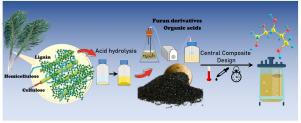Chemical Engineering Research and Design ( IF 3.7 ) Pub Date : 2022-01-12 , DOI: 10.1016/j.cherd.2022.01.008 Shareena Fairuz Abdul Manaf 1, 2 , Abdullah Amru Indera Luthfi 2, 3 , Jamaliah Md Jahim 2, 3 , Shuhaida Harun 2, 3 , Jian Ping Tan 2, 4 , Siti Syazwani Mohd Shah 2, 3

|
Acid hydrolysis pre-treatment on biomass produces furan derivatives, phenolics, and organic acids, which are harmful to the fermenting microorganisms. Removal of inhibitor compounds from the hydrolysate using coconut shell activated charcoal (CSAC) adsorption is essential to improve the quality of detoxified hydrolysate as a feedstock for xylitol production. This study investigated adsorption parameters of different pH (pH 1–7), temperature (17.5–92.5 °C), CSAC-to-hydrolysate loading (0.5–9.5% (w/v)) and contact time (30–142.5 min) using a central composite design (CCD) to evaluate the interactive effect of the adsorption process parameters on response variables. Under optimal adsorption process (pH 2.5, 55.6 °C, 5.3% (w/v) and 74 min), the results demonstrated loss of 10.4% sugar and 12.8 % of detoxified hydrolysate volume with 79.9% of furfural removal. Inhibition by acetic acid could be alleviated by pH control in bioreactor since the concentration of acetic acid was decreased by up to 73.7% at the end of OPF hydrolysate fermentation. The fermentability test using detoxified OPF hydrolysate by Kluyveromyces marxianus ATCC 36907 demonstrated 78% higher xylitol production compared to non-detoxified OPF hydrolysate. This finding corroborates that this sequential detoxification is a promising method to enhance the xylitol production using OPF hydrolysate.
中文翻译:

用椰子壳活性炭对油棕叶水解物进行顺序解毒,并在生物反应器中控制 pH 值以生产木糖醇
生物质酸水解预处理产生呋喃衍生物、酚类和有机酸,对发酵微生物有害。使用椰子壳活性炭 (CSAC) 吸附去除水解产物中的抑制剂化合物对于提高作为木糖醇生产原料的解毒水解产物的质量至关重要。本研究调查了不同 pH 值(pH 1-7)、温度(17.5-92.5 °C)、CSAC 对水解产物的负载量(0.5-9.5% (w/v))和接触时间(30-142.5 分钟)的吸附参数使用中心复合设计(CCD)来评估吸附过程参数对响应变量的交互影响。在最佳吸附过程(pH 2.5、55.6 °C、5.3% (w/v) 和 74 分钟)下,结果表明 79 损失了 10.4% 的糖和 12.8% 的解毒水解产物体积。糠醛去除率 9%。乙酸的抑制作用可以通过生物反应器中的 pH 值控制来缓解,因为乙酸浓度在 OPF 水解产物发酵结束时降低了高达 73.7%。脱毒 OPF 水解物发酵性试验与未解毒的 OPF 水解产物相比, Kluyveromyces marxianus ATCC 36907 的木糖醇产量提高了 78%。这一发现证实了这种连续解毒是一种很有前途的方法,可以使用 OPF 水解物提高木糖醇的产量。











































 京公网安备 11010802027423号
京公网安备 11010802027423号